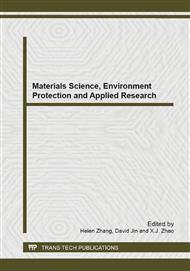[1]
Sherwin, E., Oxidation and antioxidants in fat and oil processing, Journal of the American Oil Chemists' Society, 1978. 55(11): pp.809-814.
DOI: 10.1007/bf02682653
Google Scholar
[2]
Choe, E. and D.B. Min, Mechanisms and factors for edible oil oxidation, Comprehensive Reviews in Food Science and Food Safety, 2006. 5(4): pp.169-186.
DOI: 10.1111/j.1541-4337.2006.00009.x
Google Scholar
[3]
Aidos, I., Lourenclo, S., Padt, A. V. D., Luten, J. B., & Boom, R. M., Stability of crude herring oil produced from fresh byproducts: influence of temperature during storage, Journal of Food Science, 2002. 67(9): pp.3314-3320.
DOI: 10.1111/j.1365-2621.2002.tb09585.x
Google Scholar
[4]
Ansorena, D. and I. Astiasaran, Effect of storage and packaging on fatty acid composition and oxidation in dry fermented sausages made with added olive oil and antioxidants, Meat Science, 2004. 67(2): pp.237-244.
DOI: 10.1016/j.meatsci.2003.10.011
Google Scholar
[5]
Schmidt, R. and E. Hecker, Autoxidation of phorbol esters under normal storage conditions. Cancer Research, 1975. 35(5): pp.1375-1377.
Google Scholar
[6]
Valencia, I., D. Ansorena, and I. Astiasarán, Stability of linseed oil and antioxidants containing dry fermented sausages: A study of the lipid fraction during different storage conditions, Meat Science, 2006. 73(2): pp.269-277.
DOI: 10.1016/j.meatsci.2005.12.002
Google Scholar
[7]
Frankel, E., In search of better methods to evaluate natural antioxidants and oxidative stability in food lipids. Trends in Food Science & Technology, 1993. 4(7): pp.220-225.
DOI: 10.1016/0924-2244(93)90155-4
Google Scholar
[8]
Frankel, E.N., Antioxidants in lipid foods and their impact on food quality, Food Chemistry, 1996. 57(1): pp.51-55.
DOI: 10.1016/0308-8146(96)00067-2
Google Scholar
[9]
Wilhelm, E., R. Battino, and R.J. Wilcock, Low-pressure solubility of gases in liquid water, Chemical Reviews, 1977. 77(2): pp.219-262.
DOI: 10.1021/cr60306a003
Google Scholar
[10]
Wiebe. R., Gaddy. V. L, Heins. C, Solubility of Nitrogen in Water at 25℃ from 25 to 100 Atmospheres, Industrial and Engineering Chemistry Research,1932. 24(8): p.927.
DOI: 10.1021/ie50272a023
Google Scholar
[11]
Luehring, P. and A. Schumpe, Gas solubilities (hydrogen, helium, nitrogen, carbon monoxide, oxygen, argon, carbon dioxide) in organic liquids at 293. 2 K, Journal of Chemical and Engineering Data, 1989. 34(2): pp.250-252.
DOI: 10.1021/je00056a029
Google Scholar
[12]
Battino, R. and H.L. Clever, The solubility of gases in liquids. Chemical Reviews, 1966. 66(4): pp.395-463.
DOI: 10.1021/cr60242a003
Google Scholar
[13]
Aho, L. and Ö. Wahlroos, A comparison between determinations of the solubility of oxygen in oils by exponential dilution and chemical methods, Journal of the American Oil Chemists' Society, 1967. 44(2): pp.65-66.
DOI: 10.1007/bf02558154
Google Scholar
[14]
Dohrn, R. and G. Brunner, High-pressure fluid-phase equilibria: experimental methods and systems investigated (1988-1993), Fluid Phase Equilibria, 1995. 106(1-2): pp.213-282.
DOI: 10.1016/0378-3812(95)02703-h
Google Scholar
[15]
Fornari, R.E., P. Alessi, and I. Kikic, High pressure fluid phase equilibria: experimental methods and systems investigated (1978-1987), Fluid Phase Equilibria, 1990. 57(1-2): pp.1-33.
DOI: 10.1016/0378-3812(90)80010-9
Google Scholar
[16]
Ndiaye, P. M., Tavares, F. W., Dalmolin, I., Dariva, C., Oliveira, D., & Oliveira, J. V. , Vapor pressure data of soybean oil and sunflower oil, castor oil, and their fatty acid ethyl ester derivatives, Journal of Chemical & Engineering Data, 2005. 50(2): pp.330-333.
DOI: 10.1021/je049898o
Google Scholar
[17]
Yuan, W., A. Hansen, and Q. Zhang, Vapor pressure and normal boiling point predictions for pure methyl esters and biodiesel fuels, Fuel, 2005. 84(7): pp.943-950.
DOI: 10.1016/j.fuel.2005.01.007
Google Scholar
[18]
Susial, P., Ortega, J., De Alfonso, C., and Alonso, C. , Vapor-liquid equilibrium measurements for the methyl propanoate-ethanol and methyl propanoate-propanol at 101. 32 kPa, Journal of Chemical and Engineering Data, 1989. 34(2): pp.247-250.
DOI: 10.1021/je00056a028
Google Scholar


